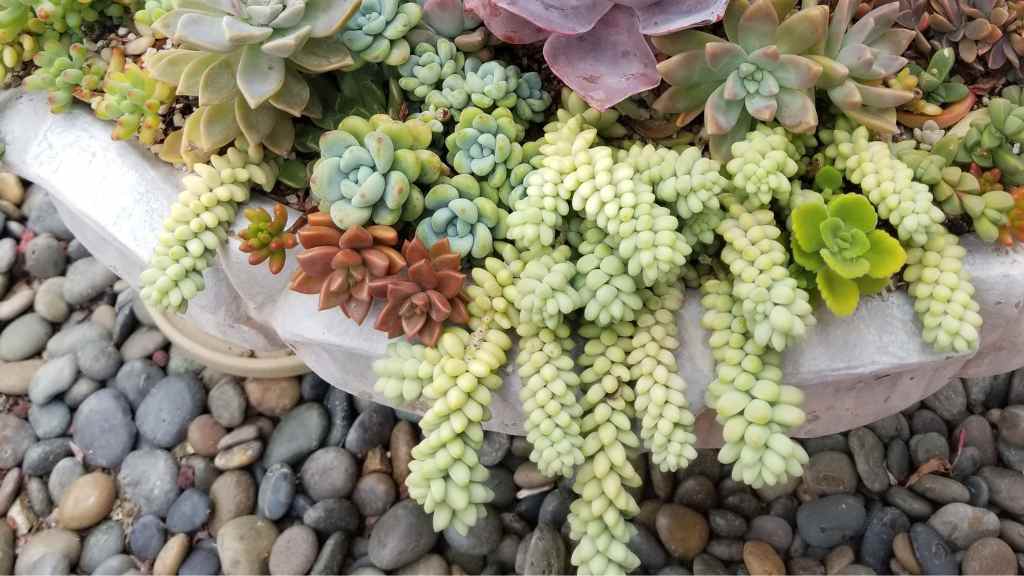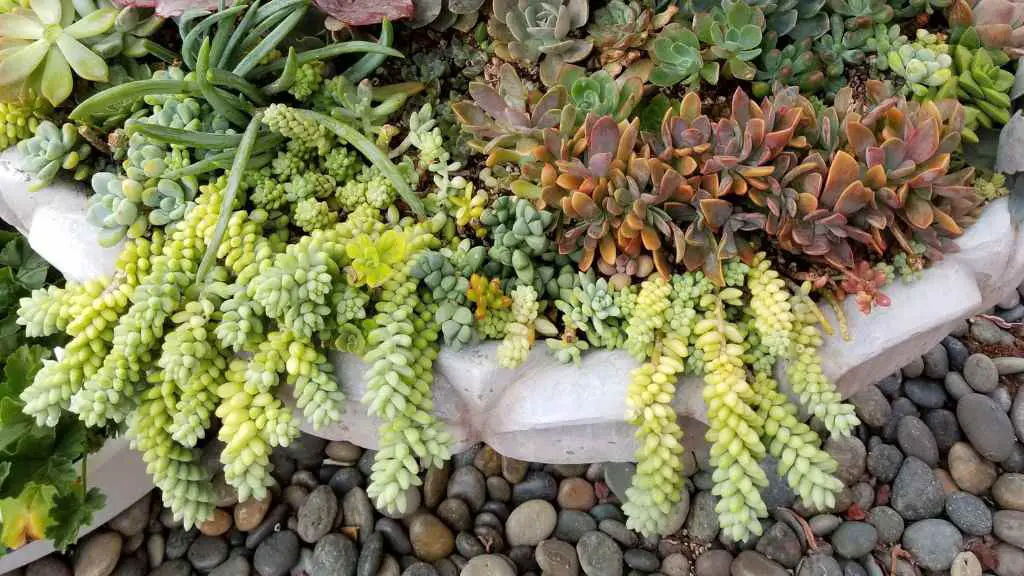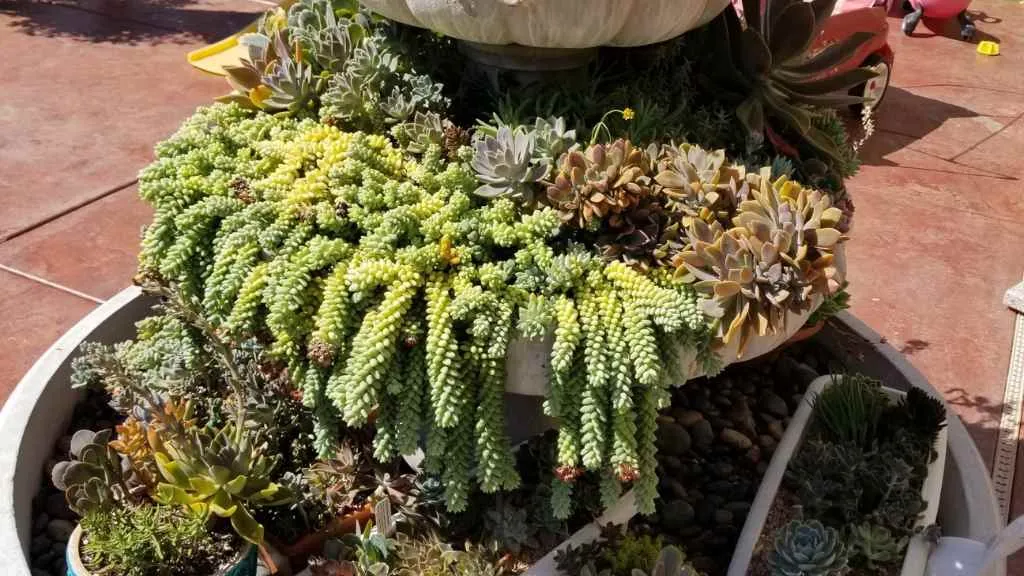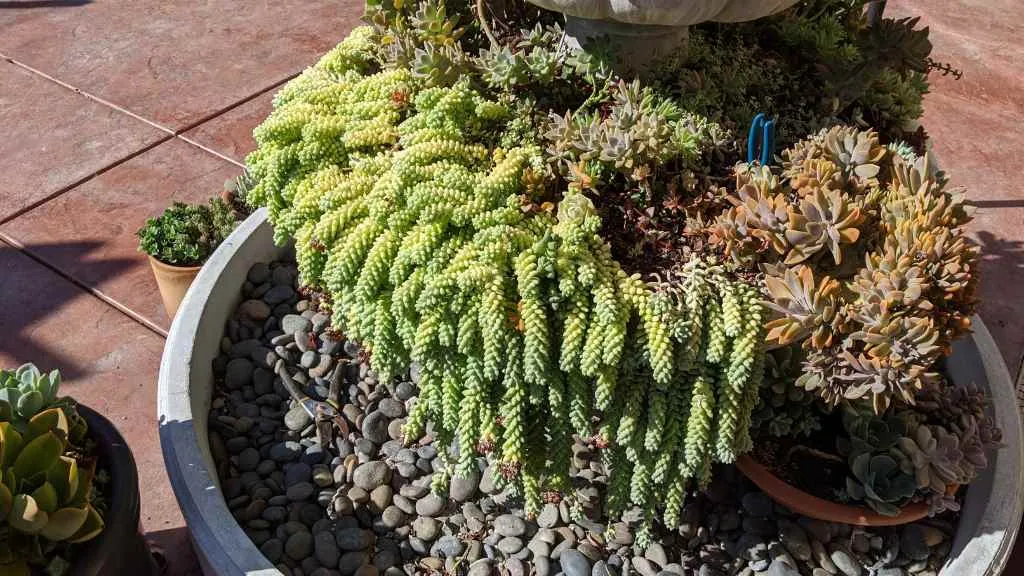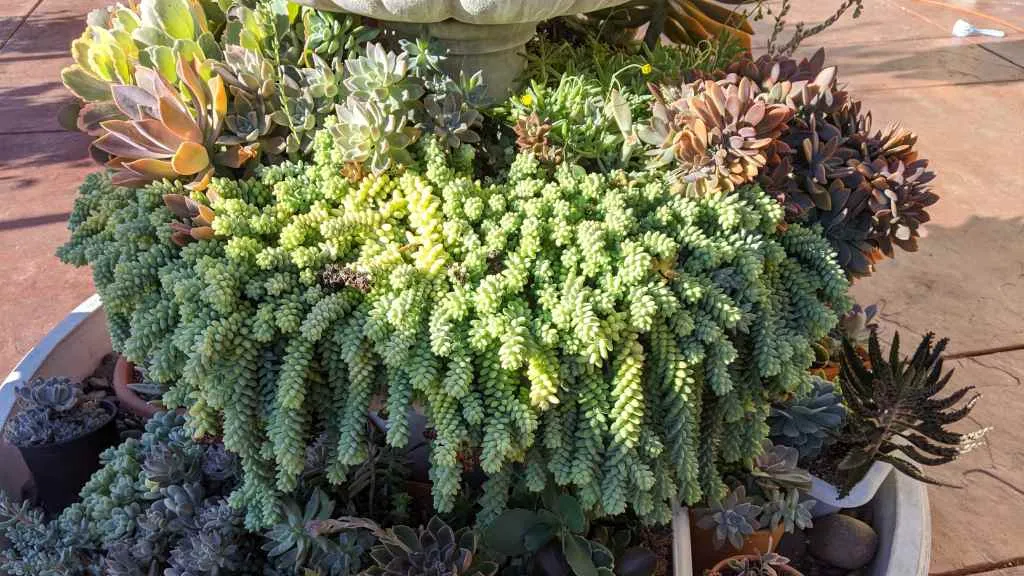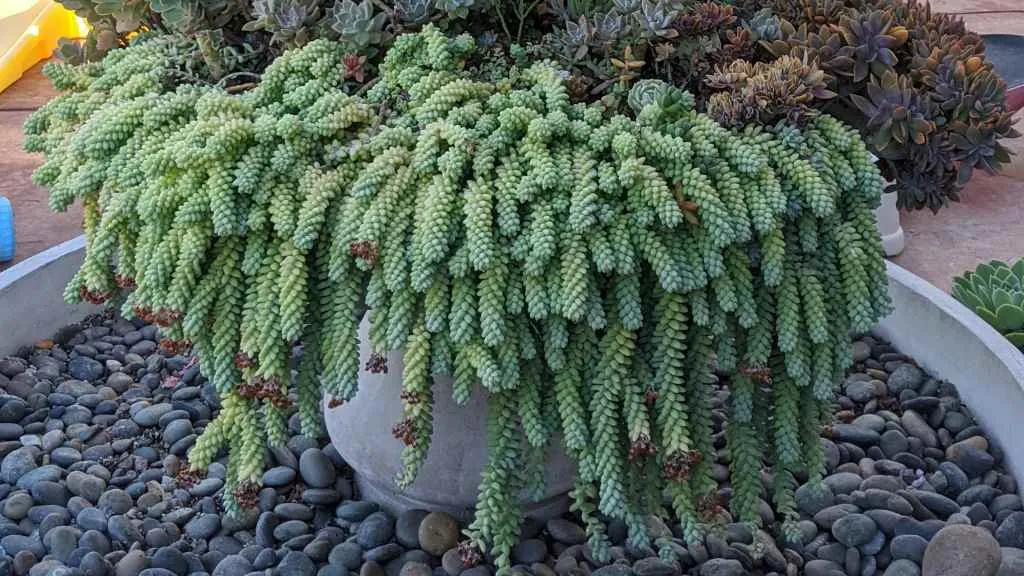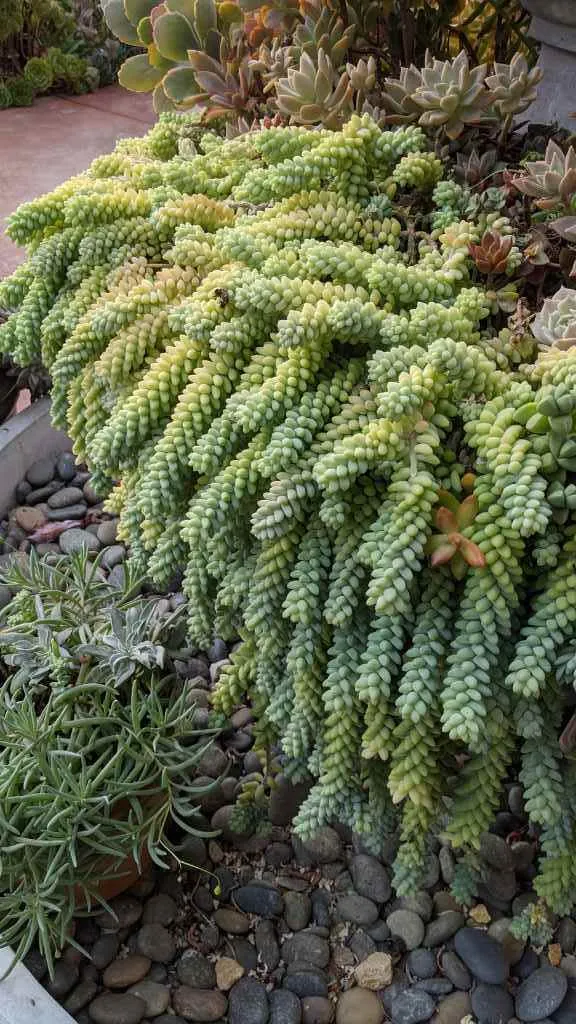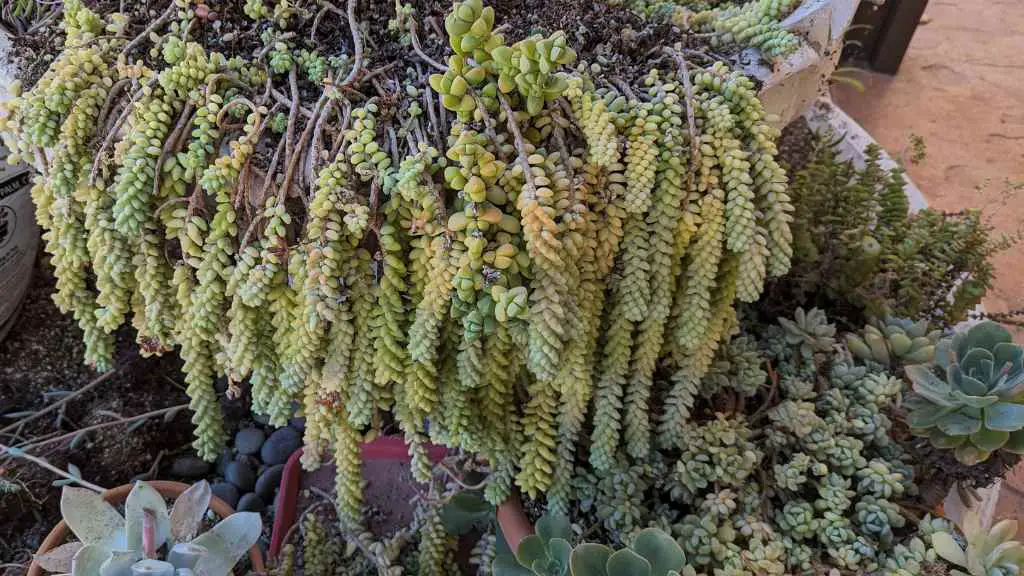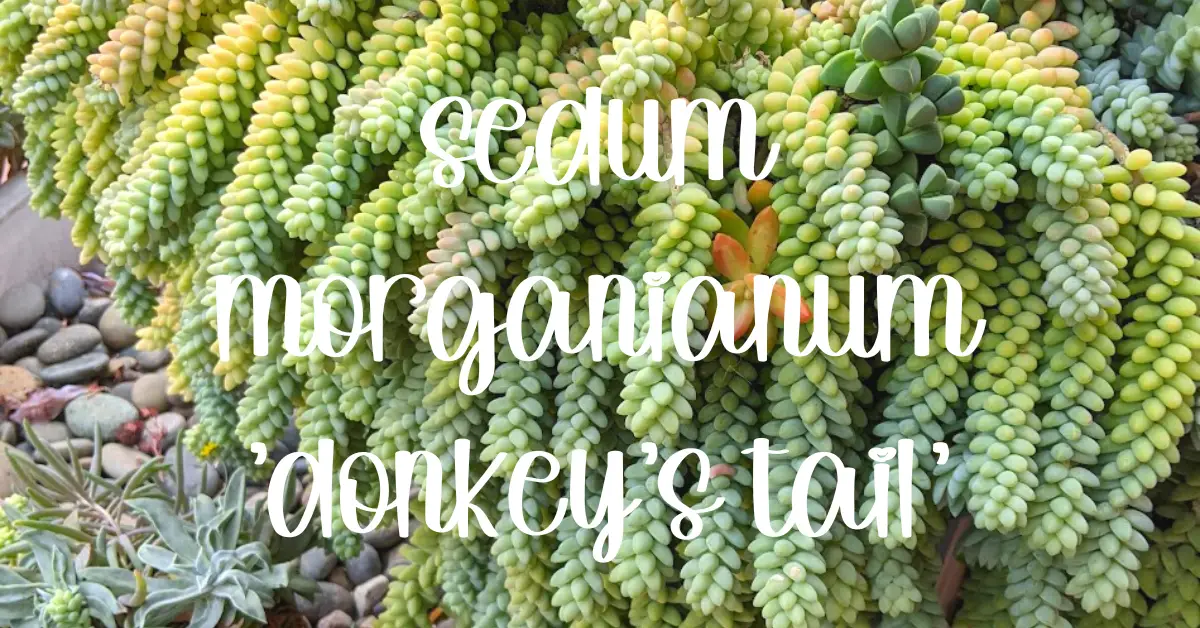Welcome to our comprehensive care guide for Sedum morganianum, commonly known as ‘Burro’s Tail.’ In this guide, we will provide all the information you need to know about this unique succulent. From its natural habitat and special adaptations to its care requirements and common problems, we’ve got you covered. Whether you’re a beginner or an experienced succulent enthusiast, this guide will help you care for your Sedum morganianum and ensure its healthy growth.
Dig in!

Natural Habitat and Common Names
Sedum morganianum ‘Burro’s Tail’ is native to the hot, dry regions of southern Mexico. It is commonly found growing in mountainous areas with rocky terrain. In its natural habitat, Sedum morganianum ‘Burro’s Tail’ often grows on cliffs and rocky outcrops, where it takes advantage of the well-draining soil and ample sunlight.
Aside from its botanical name, Sedum morganianum, this succulent is commonly known as ‘Burro’s Tail’ or Sedum ‘Burrito’ due to its long, trailing stems that resemble the tail of a baby donkey.
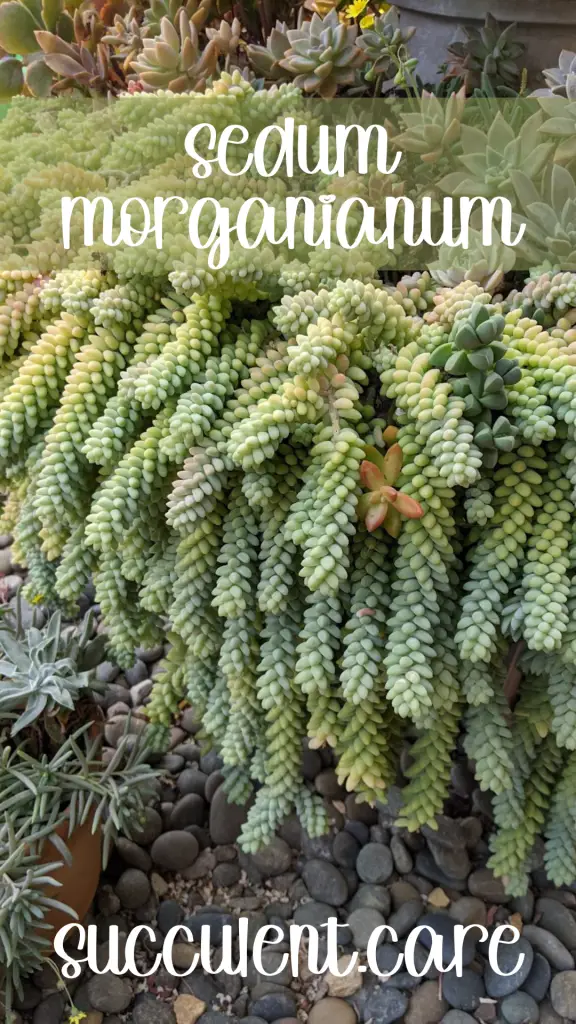
Unique Adaptations
Sedum morganianum ‘Burro’s Tail’ has several unique adaptations that set it apart from other succulents. One of its most distinctive features is its trailing stems, which can grow up to 3 feet (90 cm) in length. These stems are covered in thick, fleshy leaves that store water, allowing the plant to survive in arid conditions. The leaves are blue-green in color and have a cylindrical shape, giving the plant a unique and attractive appearance.

Source: Etsy
Differentiating Sedum morganianum ‘Burro’s Tail’
Sedum morganianum ‘Burro’s Tail’ can be differentiated from other succulents by its long trailing stems and cylindrical leaves. While there are other succulents with trailing growth habits, the combination of the long stems and cylindrical leaves is a characteristic feature of Sedum morganianum ‘Burro’s Tail’. Additionally, the blue-green color of the leaves adds to its distinctiveness. There’s also a variety that is pointed on the ends which is commonly known as ‘Donkey’s Tail.’
Appearance and Growth
Sedum morganianum ‘Burro’s Tail’ has a cascading growth habit, with its long trailing stems hanging down from the container or hanging basket. The leaves are tightly packed along the stems, creating a dense and lush appearance. The leaves are approximately 1 inch (2.5 cm) long and have a slightly rounded tip.
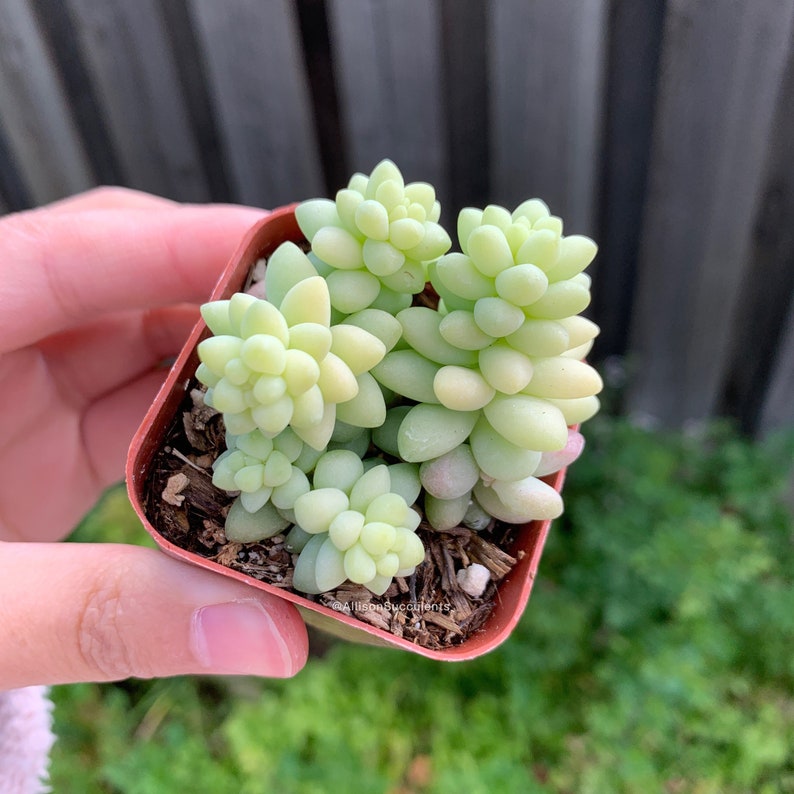
Source: Etsy
In terms of height, Sedum morganianum ‘Burro’s Tail’ can reach up to 3 feet (90 cm) when fully grown. However, the plant’s growth rate is relatively slow, so it may take several years to reach its maximum height.
Flowers and Bloom Period
Sedum morganianum ‘Burro’s Tail’ produces small, star-shaped flowers that typically appear in late summer or early fall. The flowers are usually pink or red in color, adding a splash of color to the trailing stems. However, it’s important to note that not all Sedum morganianum ‘Burro’s Tail’ plants will flower, especially when grown indoors.

Source: Etsy
The plant’s bloom is triggered by the changing light and temperature conditions as the summer transitions into fall. While the flowers themselves are relatively small and short-lived, they can still add a delightful touch to your Sedum morganianum ‘Burro’s Tail’.
Growth Rate and Season
Sedum morganianum ‘Burro’s Tail’ has a slow growth rate compared to some other succulents. It is a perennial plant, meaning it can live for several years with proper care. The plant tends to grow actively during the spring and summer months when the temperatures are warmer and the days are longer. In winter, Sedum morganianum ‘Burro’s Tail’ enters a period of dormancy, during which its growth slows down significantly.

Source: Etsy
Light Requirements and Cold Hardiness
Sedum morganianum ‘Burro’s Tail’ thrives in bright, indirect light. Ideally, it should be placed in a location that receives at least 4-6 hours of sunlight per day. However, it’s important to protect the plant from intense, direct sunlight, as it can cause sunburn on the leaves.
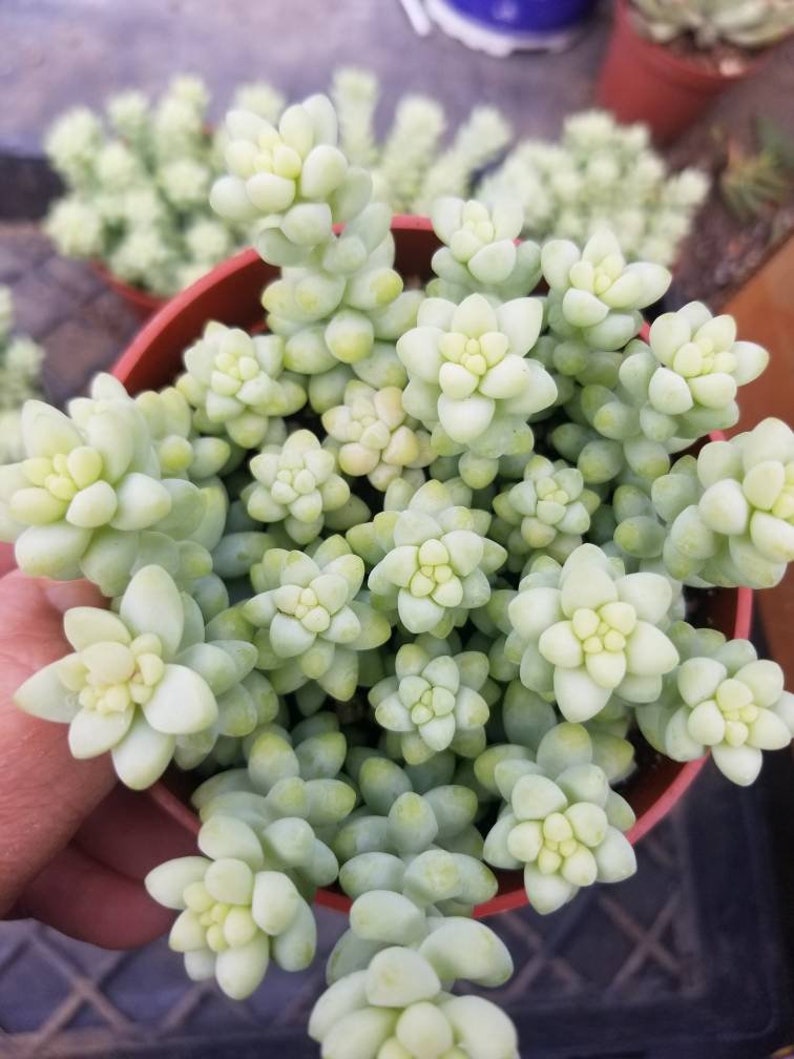
Source: Etsy
In terms of cold hardiness, Sedum morganianum ‘Burro’s Tail’ is not frost-tolerant and should be protected from freezing temperatures. It is best suited for USDA hardiness zones 10-11. If you live in a colder climate, it’s advisable to bring your Sedum morganianum ‘Burro’s Tail’ indoors during the winter months or provide it with adequate protection.
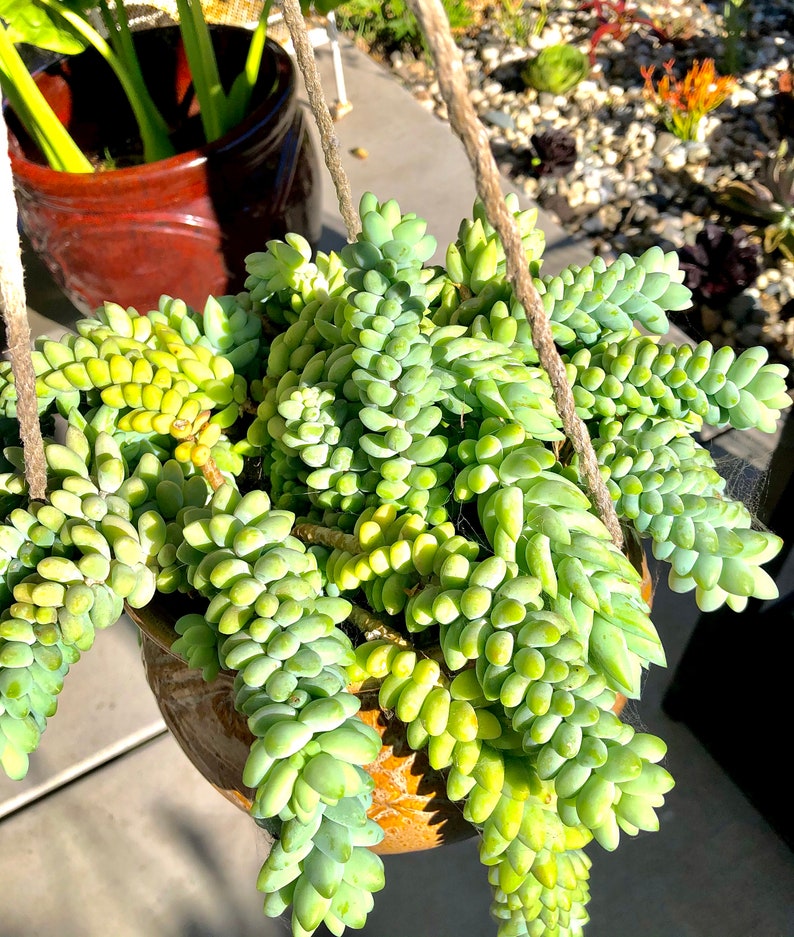
Source: Etsy
Watering and Care
Sedum morganianum ‘Burro’s Tail’ is a drought-tolerant succulent that requires infrequent watering. Overwatering can lead to root rot, so it’s important to allow the soil to dry out completely between waterings. As a general rule, water your Sedum morganianum ‘Burro’s Tail’ when the top inch (2.5 cm) of soil feels dry. During the winter dormancy period, reduce watering even further to prevent excessive moisture in the soil.
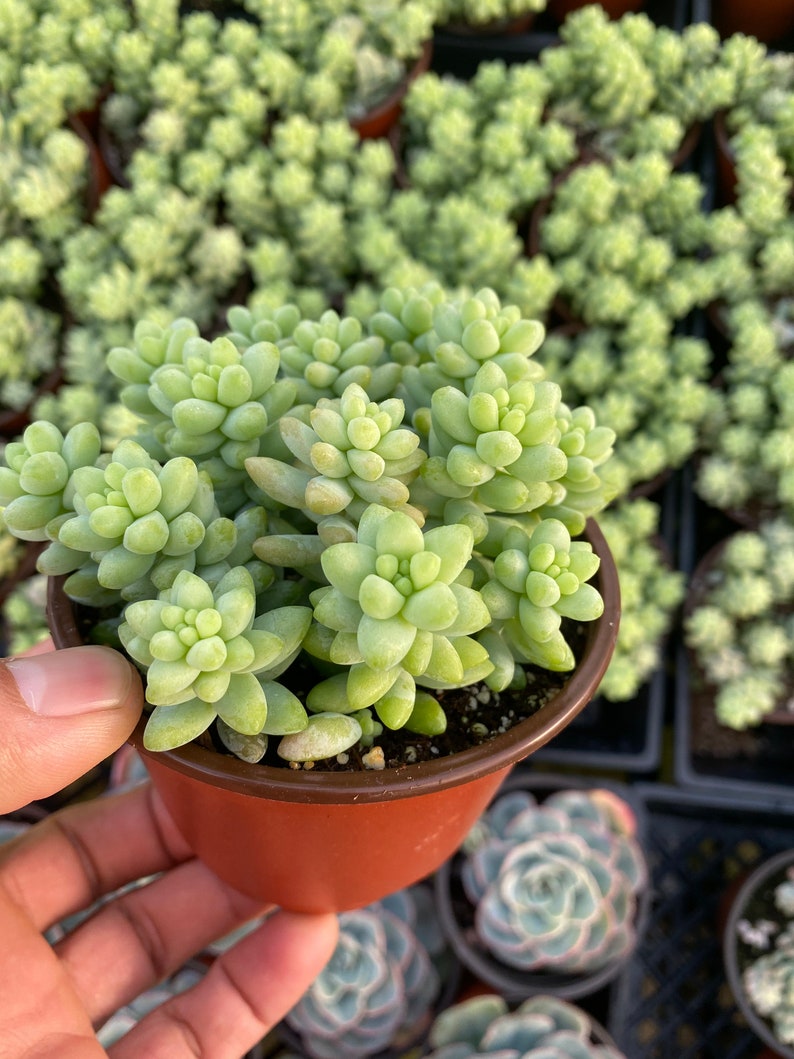
Source: Etsy
When watering, ensure that you water the soil directly and avoid wetting the leaves, as this can lead to rot. It’s also important to use well-draining soil to prevent water from sitting around the roots, as this can cause root rot. A cactus or succulent potting mix is ideal for Sedum morganianum ‘Burro’s Tail’.
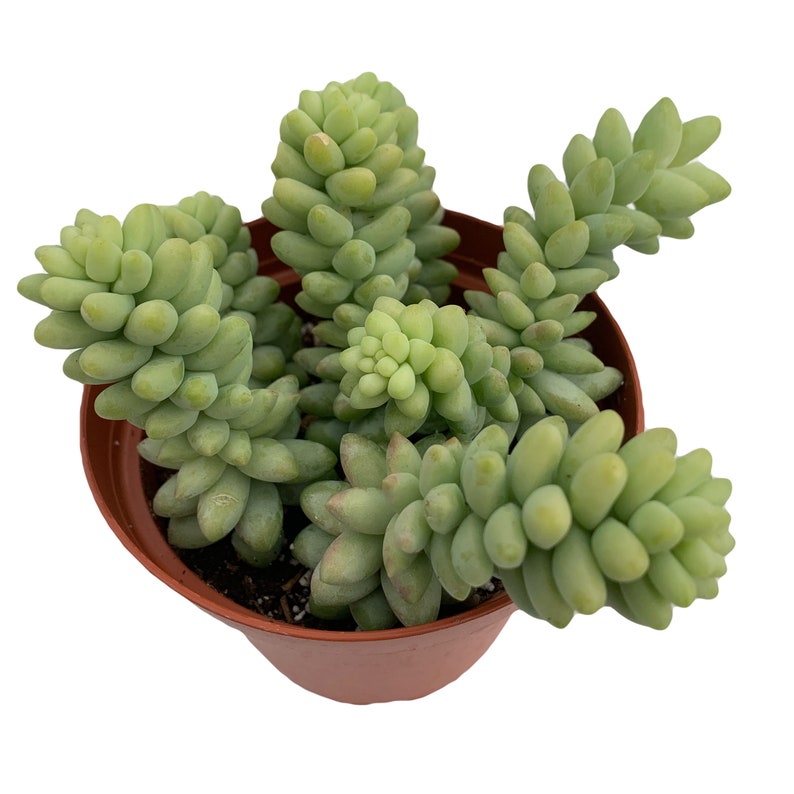
Source: Etsy
In addition to watering, Sedum morganianum ‘Burro’s Tail’ benefits from occasional fertilization during the growing season. A balanced, water-soluble fertilizer formulated for succulents can be applied every 2-4 weeks. However, it’s important to dilute the fertilizer to half or quarter strength to avoid overfeeding the plant.
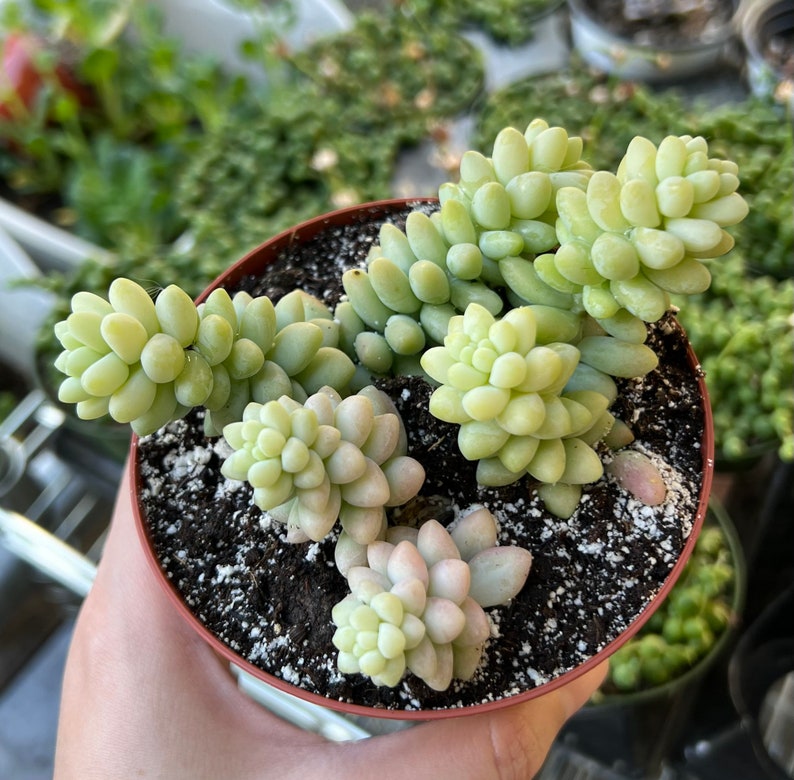
Source: Etsy
Propagation
Sedum morganianum ‘Burro’s Tail’ can be propagated through stem cuttings. To propagate your ‘Burro’s Tail,’ simply take a stem cutting with a clean, sharp knife or pair of scissors. Allow the cutting to callus over for a day or two to prevent rotting, and then place it in a well-draining potting mix. Keep the soil lightly moist and provide bright, indirect light. Over time, the cutting will develop roots and begin to grow into a new plant.
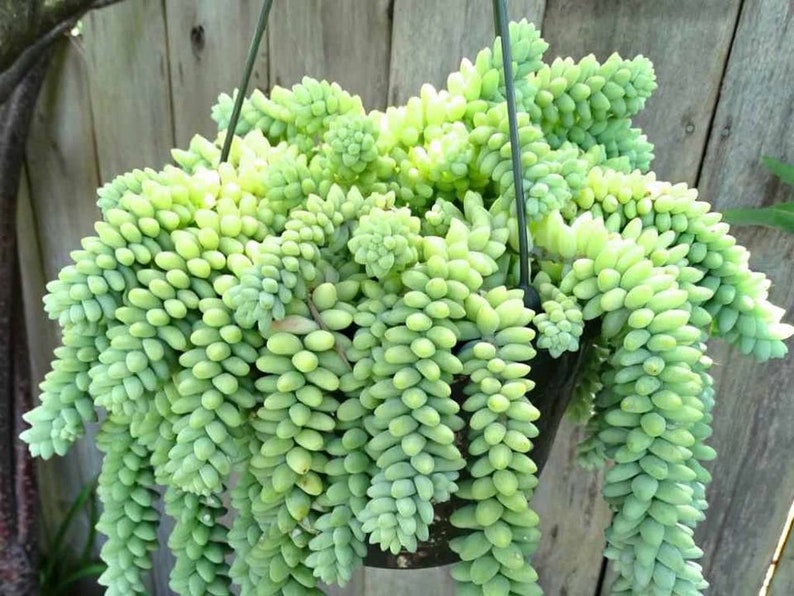
Source: Etsy
Common Problems and Solutions
While Sedum morganianum ‘Burro’s Tail’ is generally a hardy and low-maintenance plant, it can still face a few common problems. Here are some issues you may encounter and their potential solutions:
- Overwatering: One of the most common problems with Sedum morganianum ‘Burro’s Tail’ is overwatering, which can lead to root rot. Ensure that you allow the soil to dry out completely between waterings and avoid keeping the plant in consistently moist conditions.
- Leaf Drop: If your Sedum morganianum ‘Burro’s Tail’ starts dropping leaves, it could be due to underwatering, overwatering, or sudden changes in light or temperature. Assess your watering routine and ensure that the plant is not exposed to extreme conditions.
- Pests: While Sedum morganianum ‘Burro’s Tail’ is relatively pest-resistant, it may occasionally attract mealybugs or aphids. If you notice any signs of infestation, such as cotton-like webs or tiny insects on the leaves, you can treat the plant with a diluted insecticidal soap or wipe the leaves with a cotton swab dipped in rubbing alcohol.
- Stem Breakage: The trailing stems of Sedum morganianum ‘Burro’s Tail’ are delicate and prone to breakage. Take care when handling the plant and avoid placing it in areas with frequent foot traffic or where it may be exposed to strong winds.
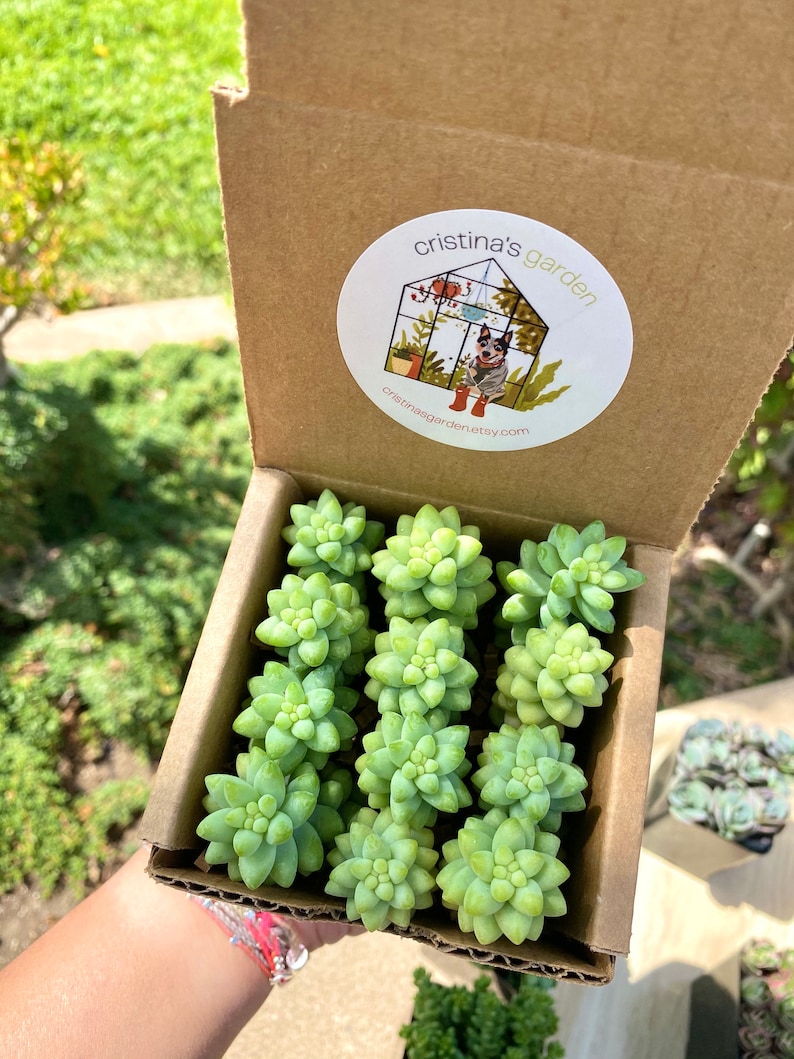
Source: Etsy
Sedum morganianum, or ‘Burro’s Tail,’ is a unique and visually appealing succulent that can add a touch of elegance to any indoor or outdoor space. With the right care and attention, this trailing succulent can thrive and bring joy for many years to come. Remember to provide it with bright, indirect light, well-draining soil, and infrequent watering. By following the guidelines in this comprehensive care guide, you can ensure the healthy growth of your Sedum morganianum ‘Burro’s Tail’ and enjoy its beauty and charm.
Visual Progression Pics of the Burro’s Tail in My Succulent Fountain
